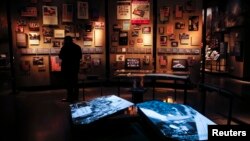A new museum that remembers the horror of the September 11, 2001 terrorist attacks in the United States is set to open in New York.
U.S. President Barack Obama is dedicating the National September 11 Memorial Museum on Thursday, and it opens to the public next week.
The museum is located on the footprint of the once-spiraling twin towers of the World Trade Center, destroyed when al-Qaida terrorists commandeered commercial passenger jets and flew them into the upper floors of the skyscrapers.
The $700-million museum and memorial plaza has been years in the making. Its completion has often been troubled by disputes over its design, construction delays and, to this day, whether unidentified remains of some of the victims of the attacks should be buried in the depths of the new structure or above ground.
The museum is almost entirely underground, extending to the bedrock where the steel supporting the World Trade Center was anchored. Massive pieces of distorted steel recovered from its destruction are on display, as are a wide array of remembrances of the attack. There are pictures of those killed, a handwritten plea for rescue and voices of people from around the world recalling where they were when they heard about the attack and watched the day's horror unfold on live television.
A film, The Rise of al-Qaida, can be seen at the end of the exhibition.
When entering and leaving the museum, visitors can look up through a glass ceiling and see a new tower, One World Trade Center, that is scheduled to open late this year.
The 2001 terrorist attacks killed nearly 3,000 people, including at the Defense Department outside Washington and the Shanksville, Pennsylvania, area
U.S. President Barack Obama is dedicating the National September 11 Memorial Museum on Thursday, and it opens to the public next week.
The museum is located on the footprint of the once-spiraling twin towers of the World Trade Center, destroyed when al-Qaida terrorists commandeered commercial passenger jets and flew them into the upper floors of the skyscrapers.
The $700-million museum and memorial plaza has been years in the making. Its completion has often been troubled by disputes over its design, construction delays and, to this day, whether unidentified remains of some of the victims of the attacks should be buried in the depths of the new structure or above ground.
The museum is almost entirely underground, extending to the bedrock where the steel supporting the World Trade Center was anchored. Massive pieces of distorted steel recovered from its destruction are on display, as are a wide array of remembrances of the attack. There are pictures of those killed, a handwritten plea for rescue and voices of people from around the world recalling where they were when they heard about the attack and watched the day's horror unfold on live television.
A film, The Rise of al-Qaida, can be seen at the end of the exhibition.
When entering and leaving the museum, visitors can look up through a glass ceiling and see a new tower, One World Trade Center, that is scheduled to open late this year.
The 2001 terrorist attacks killed nearly 3,000 people, including at the Defense Department outside Washington and the Shanksville, Pennsylvania, area







